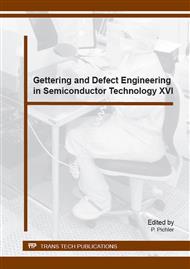[1]
L. Pelaz, et al., B diffusion and clustering in ion implanted Si: The role of B cluster precursors, Appl. Phys. Lett. 70 (1997) 2285-2287.
DOI: 10.1063/1.118839
Google Scholar
[2]
N.E.B. Cowern, et al., Energetics of self-interstitial clusters in Si, Phys. Rev. Lett. 82 (1999) 4460-4463.
Google Scholar
[3]
S. Libertino, S. Coffa, and J.L. Benton, Formation, evolution and annihilation of interstitial clusters in ion-implanted silicon. Phys. Rev. B 63 (2001) 195206-(1-14).
DOI: 10.1103/physrevb.63.195206
Google Scholar
[4]
J. Kim, et al., Thermally activated reorientation of di-interstitial defects in silicon, Phys. Rev. Lett. 83 (1999) 1990-(1993).
DOI: 10.1103/physrevlett.83.1990
Google Scholar
[5]
S.K. Estreicher, et al., Unexpected dynamics for self-interstitial clusters in silicon, Phys. Rev. B 86 (2001) 1247-1250.
DOI: 10.1103/physrevlett.86.1247
Google Scholar
[6]
Y.A. Du, R.G. Hennig, and J.W. Wilkins, Diffusion mechanisms for silicon di-interstitial, Phys. Rev. B 73 (2006) 245203-(1-5).
Google Scholar
[7]
M. Posselt, F. Gao, and D. Zwicker, Atomistic study of the migration of di- and-interstitials in silicon, Phys. Rev. B 71 (2005) 245202-(1-12).
DOI: 10.1103/physrevb.71.245202
Google Scholar
[8]
G.M. Lopez and V. Fiorentini, Structure, energetic, and extrinsic levels of small self-interstitial clusters in silicon, Phys. Rev. B 69 (2004) 155206-(1-8).
DOI: 10.1103/physrevb.69.155206
Google Scholar
[9]
S. Lee and G.S. Hwang, Growth and shape transition of small silicon self-interstitial clusters, Phys. Rev. B 78 (2008) 045204-(1-7).
DOI: 10.1103/physrevb.78.045204
Google Scholar
[10]
Y. -H. Lee, N.N. Gerasimenko, and J.W. Corbett, EPR study of neutron-irradiated silicon: A positive charge state of the <100> split di-interstitial, Phys. Rev. B 14 (1976) 4506-4520.
DOI: 10.1103/physrevb.14.4506
Google Scholar
[11]
Y. -H. Lee, Silicon di-interstitial in ion-implanted silicon, Appl. Phys. Lett. 73 (1998) 1119-1121.
DOI: 10.1063/1.122116
Google Scholar
[12]
J. Hermansson, et al., Complexes of the self-interstitial with oxygen in irradiated silicon: a new assignment of the 936 cm-1 band, Physica B 302-303 (2001) 188-192.
DOI: 10.1016/s0921-4526(01)00426-4
Google Scholar
[13]
A. Brelot and J. Charlemagne, Infrared studies of low temperature electron irradiated silicon containing germanium oxygen and carbon, Radiation Effects 9 (1971) 65-73.
DOI: 10.1080/00337577108242034
Google Scholar
[14]
L.I. Khirunenko, et al., Self-interstitial-oxygen related defects in low-temperature irradiated Si, Physica B 308-310 (2001) 458-461.
DOI: 10.1016/s0921-4526(01)00731-1
Google Scholar
[15]
G. Davies, et al., Radiation damage in silicon exposed to high-energy protons, Phys. Rev. B 73 (2006) 165202-(1-10).
Google Scholar
[16]
L. Dobaczewski, A.R. Peaker and K. Bonde Nielsen, Laplace-transform deep-level transient spectroscopy: The technique and its applications to the study of point defects in semiconductors, J. Appl. Phys. 96 (2004) 4689-4728.
DOI: 10.1063/1.1794897
Google Scholar
[17]
M. Mikelsen, et al., Kinetics of divacancy annealing and divacancy-oxygen formation in oxygen-enriched high-purity silicon, Phys. Rev. B 72 (2005) 195207-(1-6).
DOI: 10.1103/physrevb.72.195207
Google Scholar
[18]
P. Giannozzi, et al., Quantum-ESPRESSO: a modular and open-source software project for quantum simulations of materials, J. Phys. Condens.: Mat. 21 (2009) 395502-(1-19).
Google Scholar
[19]
V.E. Gusakov, Calculation of the band gap of semiconductors within the framework of the density functional method. Doklady of the National Academy of Sciences of Belarus 59 (2015) 53-57.
Google Scholar
[20]
V.E. Gusakov, A new approach for calculating of the band gap of semiconductors within the density functional method, submitted to Proceedings of this conference (2015).
Google Scholar
[21]
P.M. Money, et al., Defects energy levels in boron-doped silicon irradiated wit 1-MeV electrons, Phys. Rev. B 15 (1977) 3836-3843.
DOI: 10.1103/physrevb.15.3836
Google Scholar
[22]
M. Yamaguchi, et al., Deep level analysis of radiation-induced defect in Si crystals and solar cells. J. Appl. Phys. 86 (1999) 217-223.
Google Scholar
[23]
V.P. Markevich, et al., Electrically active radiation-induced defects in Czochralski-grown Si with low carbon content, J. Phys.: Condens. Mat. 17 (2005) S2331-S2340.
DOI: 10.1088/0953-8984/17/22/022
Google Scholar
[24]
V.P. Markevich, et al., Structure and electronic properties of trivacancy and trivacancy-oxygen defects in silicon, Phys. Status Solidi A 208 (2011) 568-571.
DOI: 10.1002/pssa.201000265
Google Scholar


